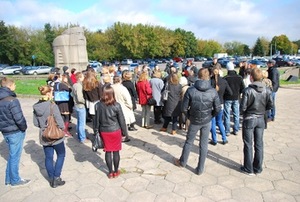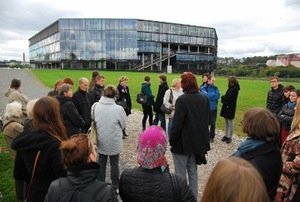Route “Progressive Kaunas Architecture” 11
In brief: The professor of philosophy Tomas Kačerauskas stated in one of his articles that “any new crazy building can ruin the existing interaction of city spaces, which forms the impression of the desired central space. At the same time it can change the city narrative by changing places of urban routes. This is why architectural “craziness” seems so dangerous to the protectors of the traditional narrative that is defended by monument protectors in the trenches…” (Urbanistika ir architektūra, 2011, No. 2).
The excursion “Progressive Kaunas Architecture” organised in Kaunas by scientists of the Architecture and City Planning Research Centre (AUTC) Dr. Vaidas Petrulis and post-graduate student Kastytis Rudokas on the last weekend of September started with this quotation in particular. The excursion was attended by a big number of Kaunas inhabitants and guests of the city. Understanding the complicated relation between the heritage protection and presence, memory and global world, in which it becomes harder to remember everything due to excess information, the researchers of AUTC decided to look at progressive features through the prism of historical perspective and contemporary scientific paradigm.
The excursion started at Kaunas Castle, the second stop was the Thunder House and Town Hall Square, which were the most outstanding signs of the period of the 15th-16th century.
Later the excursion reached reconstructions of the Soviet period, which proved that not everything that was bold and functional was also progressive. V. Petrulis discussed the development of transportation infrastructure in the central part of Kaunas.
The palace of the old fire station that marked the break of retrospectivism and modernism in Kaunas inter-war architecture was passed. A stop was made at St. Gertrude Church and the story remembered how the plan was made to construct a building of the communist party to cover the church from the side of Gruodžio Str. in 1987.
The next stop was the Central Post Office in Laisvės Alley. The “Tower” was visited, which reflected the post-industrial changes of the city. The last stop of the excursion was Žalgiris Arena, one of the more unique buildings of functional type in Europe. Although eclecticism of style is typical of the building, its form is unique. Perhaps this building will be included into the official European history of architecture in future.
Photos by Renata Kilinskaitė


